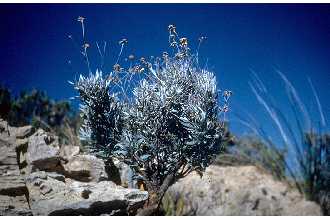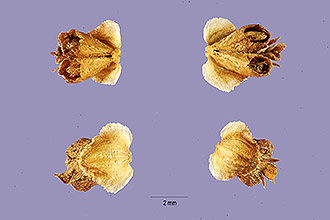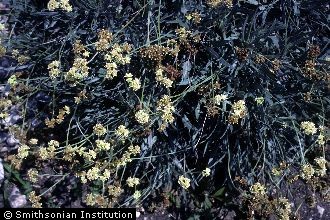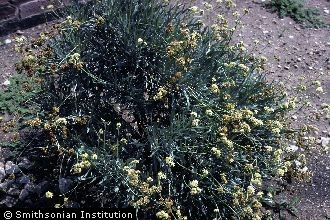Guayule
Scientific Name: Parthenium argentatum A. Gray

| General Information | |
|---|---|
| Usda Symbol | PAAR5 |
| Group | Dicot |
| Life Cycle | Perennial |
| Growth Habits | Shrub |
| Native Locations | PAAR5 |
Plant Guide
Description
General: Guayule is a perennial shrub with thick lignified stems, a low, spreading form, and an average height of approximately 20 inches (USDA, 1945). The leaves are greenish-grey and are covered with small hairs that aid in reducing evapotranspiration. Guayule has a deep, coarse taproot to collect water and nutrients from deep in the soil profile as well as a shallow fibrous system to collect moisture from brief desert rainfall (USDA, 1945; Muller, 1946). It flowers in the spring and through most of the summer months. The small, yellow composite flowers formed at the end of a stem are approximately 6 inches long. Reproduction is by facultative apomixis or sexual reproduction and results in small seeds, 0.12 inches long and 0.06 inches wide, of relatively low viability (Lloyd, 1911). Distribution: Native guayule stands are distributed throughout the northeastern parts of the Chihuahuan Desert from Mexico to the Big Bend region of Texas. For current distribution, please consult the Plant Profile page for this species on the PLANTS Website. Habitat: Guayule is frequently found in the foothills and hillslopes of the transitional zone between desert and desert grassland regions. It prefers shallow, sandy soils formed from limestone where it has the highest competitive advantage over other flora (Lloyd, 1911).
Adaptation
Guayule is a long lived, desert adapted shrub but requires more water than associated desert vegetation for active growth (Muller, 1946), During temperature or drought stress, it enters a semi-dormant state characterized by darker, grayer leaves and a lack of vegetative growth (Lloyd, 1911), Reduced metabolic periods are also seen in cultivated stands during the hottest and coldest parts of the year (Lloyd, 1911), Use soil moisture sensors to measure the soil moisture of Guayule.,
Uses
Guayule accumulates large amounts of natural rubber in its stems. Rubber production is the economic driver for its cultivation (Muller, 1946; Rasutis et al., 2015). Globally, the main contributor to commercial natural rubber production is the Pará rubber tree (Hevea brasiliensis) (The Editors of Encyclopaedia Britannica, 2020). Pará tree plantations, made-up of genetically identical clones, cannot be harvested mechanically and are genetically fragile due to their lack of genetic diversity (Sethuraj and Mathew, 1992). Guayule fields are established with genetically diverse seed and can be harvested mechanically. Harvested materials are ground into bagasse, a fine wood pulp, and the solid rubber is chemically extracted from its cells (Rasutis et al., 2015).
Ethnobotany
Guayule use has been documented in Indigenous communities. Fangmeier et al. (1984) and Lloyd (1911) report that guayule stems were chewed to extract rubber particles which were then bound together to form a ball approximately twice the size of a baseball. Natural Resources Conservation Service Plant Guide Guayule. Photo by Blase Evancho. University of Arizona Cooperative Extension.
Status
Threatened or Endangered: No Wetland Indicator: Guayule is an upland (UPL) species. Weedy or Invasive: Guayule does not display invasive or weedy characteristics. Please consult with your local NRCS Field Office, Cooperative Extension Service office, state natural resource, or state agriculture department regarding its status and use. Please consult the PLANTS Web site (http://plants.usda.gov/) and your state’s Department of Natural Resources for this plant’s current status (e.g., threatened or endangered species, state noxious status, and wetland indicator values).
Planting Guidelines
Plant guayule at a rate resulting in stand densities between 12,000 and 40,000 plants per acre (D. A. Dierig, personal communication, 5 June 2020). Foster and Coffelt (2005) recommend planting at a rate between 0.24 and 0.36 PLS (Pure Live Seed) pounds per acre. Seeding rate is highly variable and based on seed quality, planting equipment, soil type and local conditions.
Management
Guayule has two growth phases in a calendar year. In the warm season, guayule increases in biomass. In the cool season, rubber production is initiated and accumulates until spring. Harvest occurs after two to three years. During harvest, plants are cut nearly to the ground and the biomass is baled for rubber processing. After harvest, guayule sprouts back from the root stalk and supports another harvest cycle. Healthy guayule fields will be productive for at least two harvest cycles (Foster and Coffelt, 2005).
Pests and Potential Problems
Common pests of guayule during establishment are pale striped flea beetle and grasshoppers. Scout stands early and often for pests. Please contact your local agricultural extension specialist or county weed specialist to learn what works best in your area and how to use it safely. Always read label and safety instructions for each control method.
Environmental Concerns
Concerns
Concerns
None known.
Seeds and Plant Production
Plant Production
Plant Production
Guayule seed is planted in the spring or fall with a precision planter on well cultivated beds spaced 36-40 inches wide at a depth of ⅛ to ¼ inch. After planting, irrigate the furrows for 3-5 days for optimal germination and establishment. Sprinkler irrigation may be required on course textured soils or poorly prepared fields. Early season weed control is paramount.
Use
pre-emergent and post-emergent herbicide programs to control weeds. Please contact your local agricultural extension specialist or county weed specialist to learn what works best in your area and how to use it safely. Always read label and safety instructions for each control method. Once established, weeds will not outcompete guayule and will generally not require management. Reduce irrigation to approximately once a month during periods of active growth. Apply nutrients according to soil test results. Commercial scale seed harvest is accomplished from spring through fall with a highly modified cotton picker. Seed can also be harvested by hand. Seed is cleaned with commercially available equipment used for small seeded plants. Seeds produced in the spring and fall generally have higher quality and germination rates than those produced in the heat of summer (Lloyd, 1911). Cultivars, Improved, and Selected Materials (and area of origin) Guayule breeding programs have existed since the late 1800’s to develop varieties with increased rubber production but only incremental advances have been obtained. The variety grown commercially is AZ-2. It was selected for its increased biomass and rubber production compared to other lines (Ray et al. 1999).
Literature Cited
Fangmeier, D. D., D. D. Rubis, B. B. Taylor and K. E. Foster. 1984. Guayule for Rubber Production in Arizona. University of Arizona Technical Bulletin 25. Tucson, AZ. Foster, M. A., and T.A. Coffelt. 2005. Guayule Agronomics: Establishment, Irrigated Production, and Weed Control. Industrial Crops and Products 22 (1) 27-40. Lloyd F. E. 1911. Guayule A Rubber-Plant of the Chihuahuan Desert. Carnegie Institute of Washington, Washington D. C.
Conservation
Service, Tucson Plant Materials Center. Tucson, AZ. Published: October 2020 Edited: For more information about this and other plants, please contact your local NRCS field office or Conservation District at http://www.nrcs.usda.gov/ and visit the PLANTS Web site at http://plants.usda.gov/ or the Plant Materials Program web site: http://plant-materials.nrcs.usda.gov. PLANTS is not responsible for the content or availability of other Web sites. In accordance with Federal civil rights law and U.S. Department of Agriculture (USDA) civil rights regulations and policies, the USDA, its Agencies, offices, and employees, and institutions participating in or administering USDA programs are prohibited from discriminating based on race, color, national origin, religion, sex, gender identity (including gender expression), sexual orientation, disability, age, marital status, family/parental status, income derived from a public assistance program, political beliefs, or reprisal or retaliation for prior civil rights activity, in any program or activity conducted or funded by USDA (not all bases apply to all programs). Remedies and complaint filing deadlines vary by program or incident. Persons with disabilities who require alternative means of communication for program information (e.g., Braille, large print, audiotape, American Sign Language, etc.) should contact the responsible Agency or USDA's TARGET Center at (202) 720-2600 (voice and TTY) or contact USDA through the Federal Relay Service at (800) 877-8339. Additionally, program information may be made available in languages other than English. To file a program discrimination complaint, complete the USDA Program Discrimination Complaint Form, AD-3027, found online at How to File a Program Discrimination Complaint and at any USDA office or write a letter addressed to USDA and provide in the letter all of the information requested in the form. To request a copy of the complaint form, call (866) 632-9992. Submit your completed form or letter to USDA by: (1) mail: U.S. Department of Agriculture, Office of the Assistant Secretary for Civil Rights, 1400 Independence Avenue, SW, Washington, D.C. 20250-9410; (2) fax: (202) 690-7442; or (3) email: program.intake@usda.gov. USDA is an equal opportunity provider, employer, and lender.



